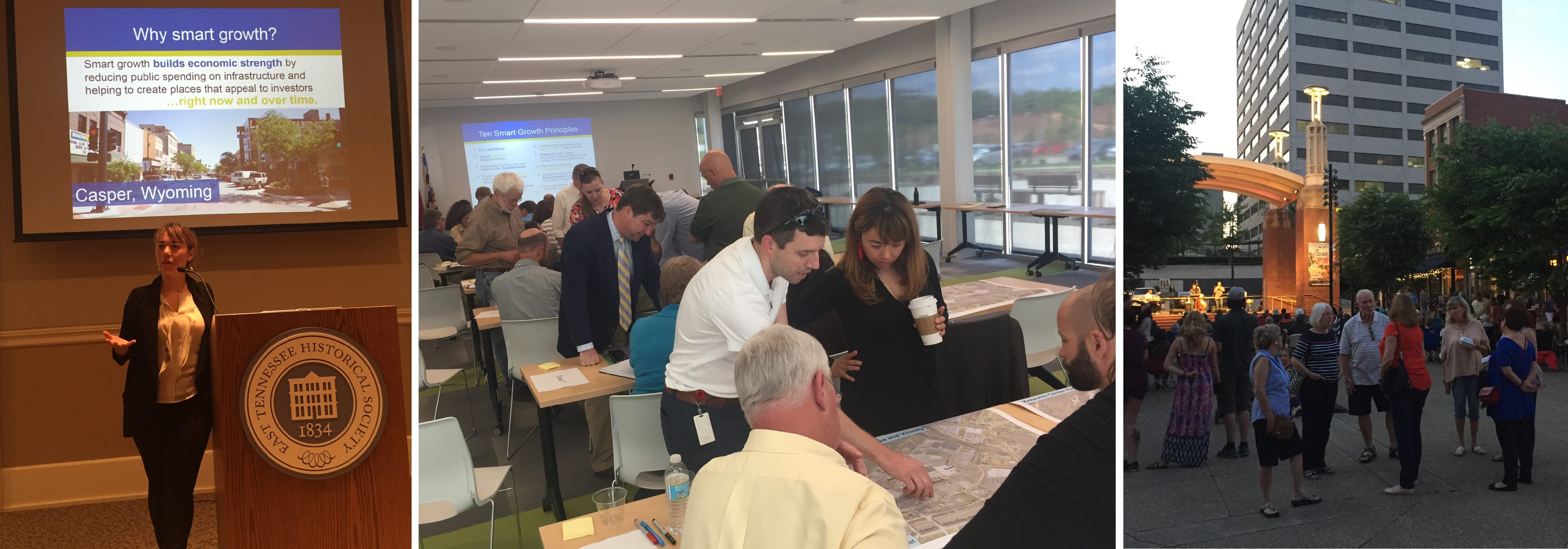
News
By Smart Growth America, June 6, 2017

Last month, Complete Streets director Emiko Atherton traveled to Knoxville, Tennessee to speak in the Walkability Speaker Series, a series that highlights the benefits of walkability and explores strategies to cultivate more walkable environments. The series is a collaborative effort led by the Knoxville Regional Transportation Planning Organization with the support of East Tennessee Quality Growth, the Knoxville Area Association of Realtors, the Knoxville Chamber, and the Knoxville Chapter of the American Planning Association. Emiko and I were excited by the opportunity to scope out Knoxville and get to know some of the local champions of smart growth and walkability, since we’ll be back before too long as part of our Complete Streets Consortium Series.
During our time in Knoxville, Emiko gave several lectures (one of which can be viewed in full here) on the principles of smart growth and the many benefits of walkable, mixed-use development including better health, cost savings, and appeal for employees and employers alike. She spoke to a broad audience including elected officials, developers, advocates, and members of the general public. Emiko also led an interactive workshop with planners and engineers to apply the principles of smart growth to a nearby case study.
The workshop focused on Knoxville Center, formerly known as East Towne Mall. We took a drive out to the site beforehand to investigate and discovered an all but abandoned shopping center in a sea of unused parking. Efforts are already under way to bring this space back to life, including holding art classes and live music events as well as replacing some of the retail space with a gym and doctors’ offices. The missing ingredient is walkability – how to bridge the vast parking lot and connect this immense, underutilized space to the surrounding neighborhoods. This was the task Emiko entrusted workshop participants with, and they tackled it with zeal, drawing over parking lots with sports fields, go-kart tracks, and lines of shops and restaurants approaching the mall entrance. They also embraced the principles of mixed-use, adding apartment buildings and office space to the site.
Knoxville has already demonstrated phenomenal successful at creating this sort of walkable town center. We spent much of our free time downtown in Market Square, a vibrant, pedestrianized boulevard ringed on all sides by restaurants with outdoor seating, rooftop bars, crafty shops, sculpture gardens, and a stage for live performances. At all hours, Market Square thrives: during the day, a farmer’s market fills the square while children play in fountains, and in the evening, live jazz music fills the air while swing dancers occupy the square. The life in Market Square spills out into the rest of downtown, where movie theaters, offices, and a general store with seldom-vacant rocking chairs out front are just a short walk away.
As I sat in Market Square reflecting on the workshop and the intriguing dialogue following each of Emiko’s lectures, it got me thinking about the challenge of creating walkability in suburban and rural contexts. Much of the work we do at Complete Streets focuses on corridors – we make it safe and convenient for pedestrians to share the street with cars, bikes, and buses. We help foster an environment where people can choose to walk wherever they need to go, whether it is home, school, work, or the grocery store. In this, Knoxville still has a long way to go. On our visit to Knoxville Center, we drove along many residential roads without sidewalks. While completing these streets by connecting sidewalks to bus services would create more transportation choices, enticing people to forego the convenience of their cars when they live miles and miles away from their destinations is challenging.
Walkable hubs like Market Square and—someday soon—Knoxville Center play an important role in overcoming this challenge. They create a culture of walkability, a place that demonstrates the benefits of thriving, walkable spaces; a place people look forward to exploring on foot, even if—at least at first—they must drive to reach it. Eventually, these walkable centers can foster enough enthusiasm and momentum to generate more investment in walkability, incrementally extending the pedestrian network outward to surrounding areas. But other changes will need to occur to support this process. Namely, revisiting land use policy. In this, Knoxville is already hard at work. Between Walkability Speaker Series lectures, Emiko and I met with high-level city staff to discuss their impending zoning ordinance update. Here, just as at the workshop and lectures, we were met with incredible enthusiasm for walkability. With supportive land use policy to encourage denser, mixed-use development and Complete Streets implementation to provide safe, convenient transportation choices, Knoxville will take great strides forward to fostering a built environment that promotes walking. The elected officials, planners, and community members we spoke with in Knoxville are excited about this work, and we’re excited to continue working with them in pursuit of this vision!
Related News

© 2025 Smart Growth America. All rights reserved
Site By3Lane Marketing










